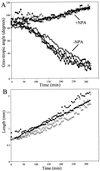Basipetal auxin transport is required for gravitropism in roots of Arabidopsis
- PMID: 10677441
- PMCID: PMC58885
- DOI: 10.1104/pp.122.2.481
Basipetal auxin transport is required for gravitropism in roots of Arabidopsis
Erratum in
- Plant Physiol. 2005 Sep;139(1):559
Abstract
Auxin transport has been reported to occur in two distinct polarities, acropetally and basipetally, in two different root tissues. The goals of this study were to determine whether both polarities of indole-3-acetic acid (IAA) transport occur in roots of Arabidopsis and to determine which polarity controls the gravity response. Global application of the auxin transport inhibitor naphthylphthalamic acid (NPA) to roots blocked the gravity response, root waving, and root elongation. Immediately after the application of NPA, the root gravity response was completely blocked, as measured by an automated video digitizer. Basipetal [(3)H]IAA transport in Arabidopsis roots was inhibited by NPA, whereas the movement of [(14)C]benzoic acid was not affected. Inhibition of basipetal IAA transport by local application of NPA blocked the gravity response. Inhibition of acropetal IAA transport by application of NPA at the root-shoot junction only partially reduced the gravity response at high NPA concentrations. Excised root tips, which do not receive auxin from the shoot, exhibited a normal response to gravity. The Arabidopsis mutant eir1, which has agravitropic roots, exhibited reduced basipetal IAA transport but wild-type levels of acropetal IAA transport. These results support the hypothesis that basipetally transported IAA controls root gravitropism in Arabidopsis.
Figures







Similar articles
-
Genetic and chemical reductions in protein phosphatase activity alter auxin transport, gravity response, and lateral root growth.Plant Cell. 2001 Jul;13(7):1683-97. doi: 10.1105/tpc.010158. Plant Cell. 2001. PMID: 11449059 Free PMC article.
-
Complex regulation of Arabidopsis AGR1/PIN2-mediated root gravitropic response and basipetal auxin transport by cantharidin-sensitive protein phosphatases.Plant J. 2005 Apr;42(2):188-200. doi: 10.1111/j.1365-313X.2005.02369.x. Plant J. 2005. PMID: 15807782
-
PINOID kinase regulates root gravitropism through modulation of PIN2-dependent basipetal auxin transport in Arabidopsis.Plant Physiol. 2009 Jun;150(2):722-35. doi: 10.1104/pp.108.131607. Epub 2009 Apr 10. Plant Physiol. 2009. PMID: 19363095 Free PMC article.
-
Root gravitropism: an experimental tool to investigate basic cellular and molecular processes underlying mechanosensing and signal transmission in plants.Annu Rev Plant Biol. 2002;53:421-47. doi: 10.1146/annurev.arplant.53.100301.135158. Annu Rev Plant Biol. 2002. PMID: 12221983 Review.
-
Auxin transport during root gravitropism: transporters and techniques.Plant Biol (Stuttg). 2014 Jan;16 Suppl 1:50-7. doi: 10.1111/plb.12030. Epub 2013 May 3. Plant Biol (Stuttg). 2014. PMID: 23648074 Review.
Cited by
-
Arabidopsis aux1rcr1 mutation alters AUXIN RESISTANT1 targeting and prevents expression of the auxin reporter DR5:GUS in the root apex.J Exp Bot. 2013 Feb;64(4):921-33. doi: 10.1093/jxb/ers371. Epub 2013 Jan 4. J Exp Bot. 2013. PMID: 23293348 Free PMC article.
-
Hydrogen sulfide modulates actin-dependent auxin transport via regulating ABPs results in changing of root development in Arabidopsis.Sci Rep. 2015 Feb 5;5:8251. doi: 10.1038/srep08251. Sci Rep. 2015. PMID: 25652660 Free PMC article.
-
Role of auxin-induced reactive oxygen species in root gravitropism.Plant Physiol. 2001 Jul;126(3):1055-60. doi: 10.1104/pp.126.3.1055. Plant Physiol. 2001. PMID: 11457956 Free PMC article.
-
Long-term inhibition by auxin of leaf blade expansion in bean and Arabidopsis.Plant Physiol. 2004 Mar;134(3):1217-26. doi: 10.1104/pp.103.032300. Epub 2004 Feb 26. Plant Physiol. 2004. PMID: 14988474 Free PMC article.
-
The MADS transcription factor CmANR1 positively modulates root system development by directly regulating CmPIN2 in chrysanthemum.Hortic Res. 2018 Oct 1;5:52. doi: 10.1038/s41438-018-0061-y. eCollection 2018. Hortic Res. 2018. PMID: 30302256 Free PMC article.
References
-
- Davies PJ, Doro JA, Tarbox AW. The movement and physiological effect of indoleacetic acid following point applications to root tips of Zea mays. Physiol Plant. 1976;36:333–337.
-
- Davies PJ, Mitchell EK. Transport of indoleacetic acid in intact roots of Phaseolus coccineus. Planta. 1972;105:139–154. - PubMed
Publication types
MeSH terms
Substances
LinkOut - more resources
Full Text Sources
Molecular Biology Databases

